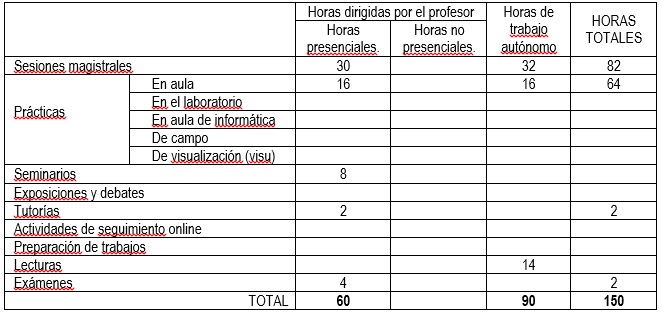GLOBAL JUSTICE AND HUMAN RIGHTS
Estudios Globales / Global Studies
Curso 2024/2025
1. Subject Information
(Date last modified: 03-06-24 11:03)- Code
- 140517
- Plan
- 405
- ECTS
- 6.00
- Type
- Compulsory
- Year
- 2
- Duration
- Second semester
- Language
- ENGLISH
- Area
- DERECHO CONSTITUCIONAL
DERECHO PROCESAL
- Departament
- Derecho Administ., Financiero y Procesal
Derecho Público General
- Virtual platform
Professor Information
- Profesor/Profesora
- Walter Reifarth Muñoz
- Group/s
- Único
- Centre
- Fac. Derecho
- Office
- 283
- Office hours
- Upon request by email
- Web address
- -
- reifarth@usal.es
- Phone
- 923 29 45 00 Ext. 6938
- Profesor/Profesora
- Marina Oliveira Teixeira Dos Santos
- Group/s
- Único
- Centre
- Fac. Derecho
- Office
- 283
- Office hours
- Upon request by email.
- Web address
- -
- marinaots@usal.es
- Phone
- -
- Profesor/Profesora
- Juan Daniel Elorza Saravia
- Group/s
- Único
- Centre
- Fac. Derecho
- Office
- 105
- Office hours
- Upon request by email
- Web address
- https://d-constitucional-usal.com/staff/juan-daniel-elorza-saravia/ https://d-constitucional-usal.com/staff/juan-daniel-elorza-saravia/
- jdelorza@usal.es
- Phone
- 923 294 500 extensión 1697
2. Association of the subject matter within the study plan
Curricular area to which the subject matter pertains.
International legal framework
Purpose of the subject within the curricular area and study plan.
This course focuses on human rights from both a theoretical and practical point of view, studying, on the one hand, the main scenarios, factors and policies that pose a risk to the enjoyment of human rights and, on the other hand, the regional, national and international institutions designed for their protection and enhancement.
Professional profile.
Public sector , international cooperation, international organisations, NGOs, research or academia, among others.
3. Prerequisites
It is advisable to have successfully completed ‘Public International Law’.
4. Learning objectives
Studying this subject will allow students to have a clear and comprehensive view about the main universal and regional systems and standards for the international protection of human rights. In doing so, special attention will be drawn to the role of courts and UN bodies in this field.
At the end of this course, students will be able to:
- identify and explain the policy, factors and key actors involved in the implementation of Global Justice;
- identify the different contexts in which Human Rights may be at risk;
- explain the relationship between Justice and Human Rights;
- distinguish between Justice as a tool and an end in itself and Human Rights as a tool and an end in itself to reach Global Justice;
- to analyze the role that Justice can play in the protection of Human Rights;
- to apply legal processes and procedures in the protection of Human Rights;
- to evaluate the current legal instruments designed in the Global Justice and guarantee of Human Rights
5. Contents
Theory.
First Part: Protection of Human Rights
- The United Nations and Human Rights: bodies and mechanisms
- Regional Systems: Europe
- Regional Systems: The Americas
- Regional Systems: Africa
Second Part: Theory and Concepts –
Problems of the System of Human Rights
5. Philosophical issues regarding the International System of Human Rights
6. Retrospective History of the foundations of Western rights and liberties (The problem of inalienability).
7. Human Dignity as a norm, as a fact, as a value. Convergence of conceptions of justice (The problem of inherence).
8. Cosmopolitism and Universalism of Human Rights (The problem of universalization)
9. Fundamental Rights and Human Rights. Constitutional Guarantees and Postwar peace imperatives (The problem of interdependence)
10. Concepts of Human and concepts of Rights (The problem of progressiveness).
Practice.
During the first part, the following list of practices is indicative
- Analysis of case-law
- Commentary on specialized texts and papers
During the Second Part of the course, the lectures will be mainly conceptual, based on the most important theoretical current problems of Humans Rights. Three of these sessions will be devoted to Forum-Debates on topics presented by teams of 5 students. This exercise combines research, teamwork and discussion, public presentation, and debate in defense of team positions. These sessions, will be based on real cases taken from the current press or recent history.
6. Competences acquired
Basic / General.
CB1, CB2, CB3, CG3, CG4
Specific.
CE3, CE4,
7. Teaching methods
The proposed teaching method will be based on a combination of theoretical classes with a practical approach to the meaning and protection of human rights. Students will be expected to have an active participation.
8. Anticipated distribution of the use of the different teaching methods

9. Resources
Reference books.
-SCHIPPERS, B. (Ed.), (2019): Critical Perspectives on Human Rights: Rowman & Littlefield, New York
-KUROSAWA, F., (2007): The Work of Global Justice. Human Rights as Practices, New York, Cambridge University Press.
-CAPPS, P., (2009), Human Dignity and the Foundations of International Law; Studies in international Law; Oxford –Portland, Hart Publishing.
-ACCONI, P., DONAT, D., MARCHESI, A., PALMISANO, G., SANTORI, V. (2017), International Law and the Protection of Humanity –Essays in Honour of Flavia Lattanzi-, Grotius Centre for International Legal Studies.
-FORSYTHE, D., (2006): Human Rights in International Relations; New York, Cambridge University Press.
-CABRERA, L., (2004): Political Theory of Global Justice. London – New York, Routledge.
-MAES, E. (2008): «Constitutional Democracy, Constitutional Interpretation and Conflicting Rights», in Conflicts Between Fundamental Rights –Eva Brems Ed.-, Oxford-Portland, Intersentia.
-CAMPBELL, T. (2006), Rights. A critical introduction, London- New York, Routledge.
-JÄGERS, N. (2002), Corporate Human Rights Obligations: in search of Accountability. Oxford- New York, Intersentia.
-KLEIN, N. (2004), «Reclaiming the Commons», in A Movement of Movements. Is another world really possible?, London, Verso.
- KRAUSE, C.; SCHEININ, M. (2009): Protection of Human Rights: a Textbook. Åbo Akademi University Institute for Human Rights.
- MERTUS, J. A. (2005): The United Nations and human rights: a guide for a new era. London; New York: Routledge.
- LEACH, P. (2005): Taking a case to the European Court of Human Rights. Oxford: Oxford University Press
- AROLD, N. L. (2007): The legal culture of the European Court of Human Rights. Boston: Martinus Nijhoff Publishers
- PASQUALUCCI, J. M. (2003): The practice and procedure of the Inter-American Court of Human Rights. Cambridge: Cambridge University Press
- SMITH, R. K. M. (2022): International Human Rights Law (10th edition). Oxford: Oxford University Press.
10. Assessment
Assessment criteria.
|
Consideraciones Generales |
|
Students must demonstrate a sufficient level of the required general, basic and specific skills to pass the course. |
|
Criterios de evaluación |
|
The assessment of the subject in the first call will be the following: I. Procedural Part (Protection of Human Rights): 50% of the final mark. 50% of the final mark: 20-question test (multiple choice) or 6 open questions at the second call.
II. Constitutional Part (The prblems of Human Rights Concepts): 50% of the final mark, divided as follows: a) 30% Forum-Debate, team assigned topics exercise (group mark). b) 20% Attendance and participation (personal mark).
Students must suffice at both parts.
|
Evaluation systems.
Continuous assessment: discussion forums, presentations, case-studies, etc.
Final exam
Assessment recommendations.
Attend and actively participate in both theoretical and practical classes
|
Recomendaciones para la recuperación. |
|
Second call: I. Procedural Part (Protection of Human Rights): 50% of the final mark. 50% of the final mark: 20-question test (multiple choice) or 6 open questions at the second call.
II. Constitutional Part (Theory and Concepts_ Problems of the System oh Human Rights): 50% of the final mark. 50% of the final mark: open questions. Students must suffice at both parts |


